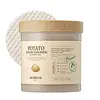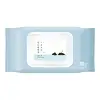What's inside
What's inside
 Key Ingredients
Key Ingredients

 Benefits
Benefits

 Concerns
Concerns

No concerns
 Ingredients Side-by-side
Ingredients Side-by-side

Water
Skin ConditioningButylene Glycol
HumectantGlycerin
HumectantNiacinamide
Smoothing1,2-Hexanediol
Skin ConditioningHydroxyacetophenone
AntioxidantPPG-13-Decyltetradeceth-24
EmulsifyingBetaine
HumectantAllantoin
Skin ConditioningSodium Citrate
BufferingDipotassium Glycyrrhizate
HumectantSolanum Tuberosum Pulp Extract
SmoothingBeta-Glucan
Skin ConditioningCitric Acid
BufferingSodium Phytate
Sodium Hyaluronate
HumectantAmmonium Acryloyldimethyltaurate/Vp Copolymer
Helianthus Annuus Seed Oil
EmollientMadecassoside
AntioxidantSodium Ascorbyl Phosphate
AntioxidantGlyceryl Acrylate/Acrylic Acid Copolymer
HumectantPogostemon Cablin Leaf Oil
MaskingDipropylene Glycol
HumectantSclerotium Gum
Emulsion StabilisingPvm/Ma Copolymer
Emulsion StabilisingSalvia Officinalis Oil
MaskingHydrogenated Lecithin
EmulsifyingPolyglyceryl-10 Laurate
Skin ConditioningCentella Asiatica Extract
CleansingAsiaticoside
AntioxidantMadecassic Acid
Skin ConditioningAsiatic Acid
Skin ConditioningLavandula Angustifolia Oil
MaskingCaffeine
Skin ConditioningSalvia Sclarea Oil
MaskingRosmarinus Officinalis Leaf Oil
MaskingCaprylyl Glycol
EmollientWater, Butylene Glycol, Glycerin, Niacinamide, 1,2-Hexanediol, Hydroxyacetophenone, PPG-13-Decyltetradeceth-24, Betaine, Allantoin, Sodium Citrate, Dipotassium Glycyrrhizate, Solanum Tuberosum Pulp Extract, Beta-Glucan, Citric Acid, Sodium Phytate, Sodium Hyaluronate, Ammonium Acryloyldimethyltaurate/Vp Copolymer, Helianthus Annuus Seed Oil, Madecassoside, Sodium Ascorbyl Phosphate, Glyceryl Acrylate/Acrylic Acid Copolymer, Pogostemon Cablin Leaf Oil, Dipropylene Glycol, Sclerotium Gum, Pvm/Ma Copolymer, Salvia Officinalis Oil, Hydrogenated Lecithin, Polyglyceryl-10 Laurate, Centella Asiatica Extract, Asiaticoside, Madecassic Acid, Asiatic Acid, Lavandula Angustifolia Oil, Caffeine, Salvia Sclarea Oil, Rosmarinus Officinalis Leaf Oil, Caprylyl Glycol
Water
Skin ConditioningMethylpropanediol
SolventDipropylene Glycol
HumectantPolyglyceryl-6 Caprylate
EmulsifyingSea Water
HumectantSodium Hyaluronate
HumectantSodium Acetylated Hyaluronate
HumectantHydrolyzed Hyaluronic Acid
HumectantAllantoin
Skin ConditioningDipotassium Glycyrrhizate
HumectantPanthenol
Skin ConditioningMaltodextrin
AbsorbentSodium Metabisulfite
AntioxidantProtease
ExfoliatingPolyglyceryl-4 Caprate
EmulsifyingSodium Citrate
BufferingHydroxyacetophenone
AntioxidantDecylene Glycol
Skin ConditioningLaurylpyridinium Chloride
AntimicrobialLevulinic Acid
PerfumingSodium Levulinate
Skin ConditioningDisodium EDTA
1,2-Hexanediol
Skin ConditioningCitric Acid
BufferingWater, Methylpropanediol, Dipropylene Glycol, Polyglyceryl-6 Caprylate, Sea Water, Sodium Hyaluronate, Sodium Acetylated Hyaluronate, Hydrolyzed Hyaluronic Acid, Allantoin, Dipotassium Glycyrrhizate, Panthenol, Maltodextrin, Sodium Metabisulfite, Protease, Polyglyceryl-4 Caprate, Sodium Citrate, Hydroxyacetophenone, Decylene Glycol, Laurylpyridinium Chloride, Levulinic Acid, Sodium Levulinate, Disodium EDTA, 1,2-Hexanediol, Citric Acid
 Reviews
Reviews

Ingredients Explained
These ingredients are found in both products.
Ingredients higher up in an ingredient list are typically present in a larger amount.
1,2-Hexanediol is a synthetic liquid and another multi-functional powerhouse.
It is a:
- Humectant, drawing moisture into the skin
- Emollient, helping to soften skin
- Solvent, dispersing and stabilizing formulas
- Preservative booster, enhancing the antimicrobial activity of other preservatives
Allantoin is a soothing ingredient known for its protective and moisturizingg properties. Because of this, it is often added to products with strong active ingredients.
Studies show higher concentrations of this ingredient can promote wound healing.
Though it can be derived from the comfrey plant, allantoin is produced synthetically for cosmetic products to ensure purity.
Learn more about AllantoinCitric Acid is an alpha hydroxy acid (AHA) naturally found in citrus fruits like oranges, lemons, and limes.
Like other AHAs, citric acid can exfoliate skin by breaking down the bonds that hold dead skin cells together. This helps reveal smoother and brighter skin underneath.
However, this exfoliating effect only happens at high concentrations (20%) which can be hard to find in cosmetic products.
Due to this, citric acid is usually included in small amounts as a pH adjuster. This helps keep products slightly more acidic and compatible with skin's natural pH.
In skincare formulas, citric acid can:
While it can provide some skin benefits, research shows lactic acid and glycolic acid are generally more effective and less irritating exfoliants.
Most citric acid used in skincare today is made by fermenting sugars (usually from molasses). This synthetic version is identical to the natural citrus form but easier to stabilize and use in formulations.
Read more about some other popular AHA's here:
Learn more about Citric AcidDipotassium Glycyrrhizate comes from licorice root.
Extracts of licorice have demonstrated to have antibacterial, anti‐inflammatory, antiviral, antioxidant properties.
One component, glabridin, has extra potent antioxidant and soothing properties. It has also been found to block pigmentation from UVB rays in guinea pigs.
Licorice Root also contains a flavonoid. Flavonoids are a natural substance from in plants. Flavonoids also have antioxidant properties.
Another component, glycyrrhizin, has been found to have anti-inflammatory and antimicrobial benefits. This may make licorice root extract effective at treating acne. However, more research is needed to support this.
Liquiritin is one of the flavone compounds found in licorice. It has been found to help lighten skin by preventing tyrosinase from reacting with tyrosine. When the two react, protein is converted to melanin. Melanin is the substance in your body that gives your features pigmentation.
Licorice root is native to Southern Europe and Asia. It has been used in traditional Chinese medicine to help with respiratory issues.
Learn more about Dipotassium GlycyrrhizateDipropylene Glycol is a synthetically created humectant, stabilizer, and solvent.
This ingredient helps:
Dipropylene glycol is technically an alcohol, but it belongs to the glycol family (often considered part of the ‘good’ alcohols). This means it is hydrating and gentle on skin unlike drying solvent alcohols like denatured alcohol.
As a masking agent, Dipropylene Glycol can be used to cover the smell of other ingredients. However, it does not have a scent.
Studies show Dipropylene Glycol is considered safe to use in skincare.
Learn more about Dipropylene GlycolHydroxyacetophenone is antioxidant with skin conditioning and soothing properties. It also boosts the efficiency of preservatives.
This ingredient is not irritating or sensitizing.
Sodium Citrate is the sodium salts of citric acid. In skincare, it is used to alter pH levels and acts as a preservative.
Its main functions are to maintain the pH of a product and neutralize metal ions.
The acidity of our skin is maintained by our glands and skin biome; normal pH level of skin is slightly acidic (~4.75-5.5).
Being slightly acidic allows our skin to create an "acid mantle". This acid mantle is a thin barrier that protects our skin from bacteria and contaminants.
Learn more about Sodium CitrateSodium Hyaluronate is hyaluronic acid's salt form. It is commonly derived from the sodium salt of hyaluronic acid.
Like hyaluronic acid, it is great at holding water and acts as a humectant. This makes it a great skin hydrating ingredient.
Sodium Hyaluronate is naturally occurring in our bodies and is mostly found in eye fluid and joints.
These are some other common types of Hyaluronic Acid:
Learn more about Sodium HyaluronateWater. It's the most common cosmetic ingredient of all. You'll usually see it at the top of ingredient lists, meaning that it makes up the largest part of the product.
So why is it so popular? Water most often acts as a solvent - this means that it helps dissolve other ingredients into the formulation.
You'll also recognize water as that liquid we all need to stay alive. If you see this, drink a glass of water. Stay hydrated!
Learn more about Water